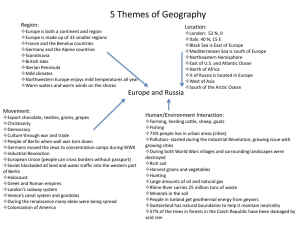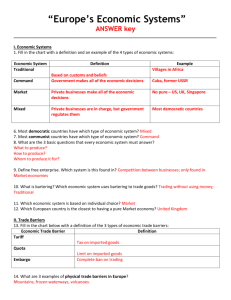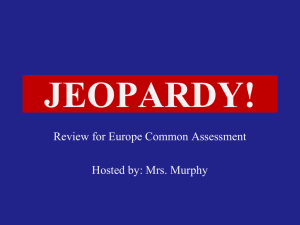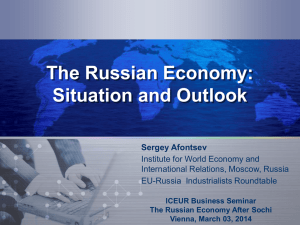Yukon Huang Presentation
advertisement
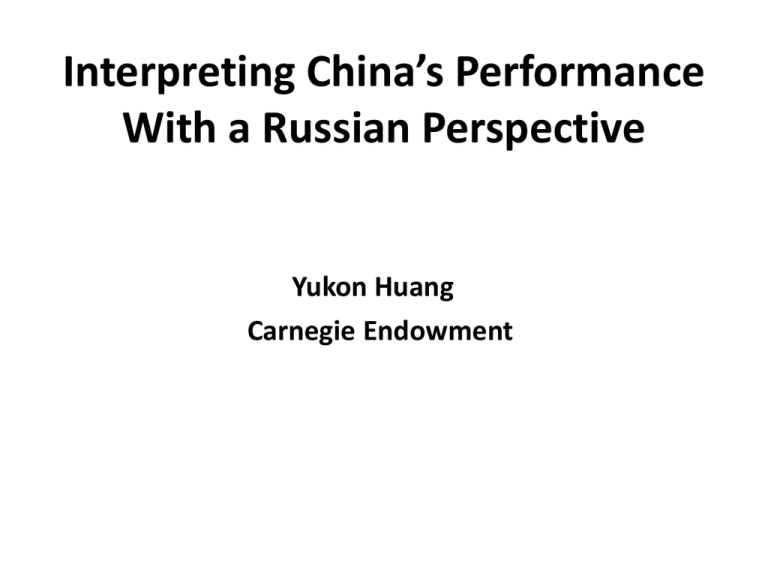
Interpreting China’s Performance With a Russian Perspective Yukon Huang Carnegie Endowment Similarities Russia Transition from planned economy YES China YES Size Largest land mass Largest population Large Trade Surplus $ 200 billion (2011) $180 billion (2012 E) Exports as % of GDP 35% (recent averages) 35% Labor productivity $7000 (VA per worker 2005) $7000 Massive Internal Migration East to West West to East Inequality (Gini coefficient) Rose from 25 to 45 Rose from 25 to 45 2 Differences Russia China Agrarian labor share of total 10% 40% Source of growth Capacity utilization and energy prices Investment and industrial expansion Resource based share of exports 80% 3% Manufactures share of exports 15% 90% Investment as % of GDP (2011) 22% 47% GDP Growth (%) Past Decade: 5% Future: 3-4% Past Decade: 10% Future: 7-8% 3 Three Key Policy Differences • Agglomeration and manufactures trade • Innovation and productivity increases • Vested interests and state capture 4 (1) Economic activity is concentrated in Asia 5 Massive migration of labor to the coast spurs concentration 6 China – location of globalized industries 7 China – location of domestic oriented industries 8 High investment rates coupled with spatial agglomeration effects increased labor productivity Labor Productivity Growth (%), 1980-2005 10 China 8 6 4 2 0 10 15 20 25 30 35 40 -2 -4 -6 Investment to Output Ratio (%) -8 9 China and Russia – Comparison of World Bank’s Business Environment Rankings CHINA RUSSIA Ease of doing business 91 120 Starting a business 151 111 Construction permits 179 178 Registering property 40 45 Getting credit 67 98 Protecting investors 97 111 Paying taxes 122 105 Trading across borders 60 160 Enforcing contracts 16 13 Resolving insolvency 75 60 Investment climate: administrative and transactions costs as a percent of sales Russia China Bribes 1.5 2.0 Infrastructure problems 6.5 2.5 Security, theft protection 3.5 1.5 Supply delays 1.0 1.5 Total 12.5 7.5 11 Regional Trade – specialized components, strong logistics and scale economies 12 Processing trade drives China’s trade surplus Trade balance (RMB bn) 40 30 20 10 0 -10 -20 Processing trade -30 Normal trade -40 2001 2002 2003 2004 2005 2006 2007 2008 2009 2010 2011 13 Russia and China – relations with global community • Differing productive structures limits growth prospects for Russia but provides flexibility for China. • China will continue to shape global market for manufactures – more in terms of variety than in just lower costs. • Russia will continue to be largely an energy/mineral supplier and vulnerable to price fluctuations. • This has political implications for how they will relate to the international community. • China needs good relationships given its dependency on the broader global market for its goods. Russia sees itself as an energy exporter to captive markets and thus less dependent on favorable relationships. 14 (2) Innovation must drive China’s future growth • Future growth should come more from innovation. • But innovation needs to be private sector driven in comparison with the past state led investment approach. • By 2030, China will have 200 million college graduates, more than the entire workforce in US but skills are deficient. • R&D spending is rising rapidly but reliance on government support is a concern. Patents are soaring but value unclear. • Some firms are getting closer to the technological frontier but overall production mix is still not technologically advanced. • Big question can China leapfrog beyond its “natural” position and develop more indigenous technology? 15 China and East Asian economies are innovating no more than comparators at similar income levels (ranking) 10 SGP TWN USA JPN HKG KOR 9 Knowledge Index 8 7 MYS 6 THA CHN 5 4 PHL IDN MNG VNM KHM LAO 3 2 1 0 6 7 8 9 Log GDP per capita 10 11 12 16 But China really stands out in terms of adoption of technology 17 Global R&D Landscape 18 (3) Vested Interests and State Capture • Russia – state capture by financial-industrial groups and a dominant leader. Influenced by “dutch disease” and resource rich governance vulnerabilities. • China – shifting from a broad coalition of growth advocates to state capture by the Party/State Banks/SOEs. State led rapid growth has generated abundant rent-seeking opportunities. 19





